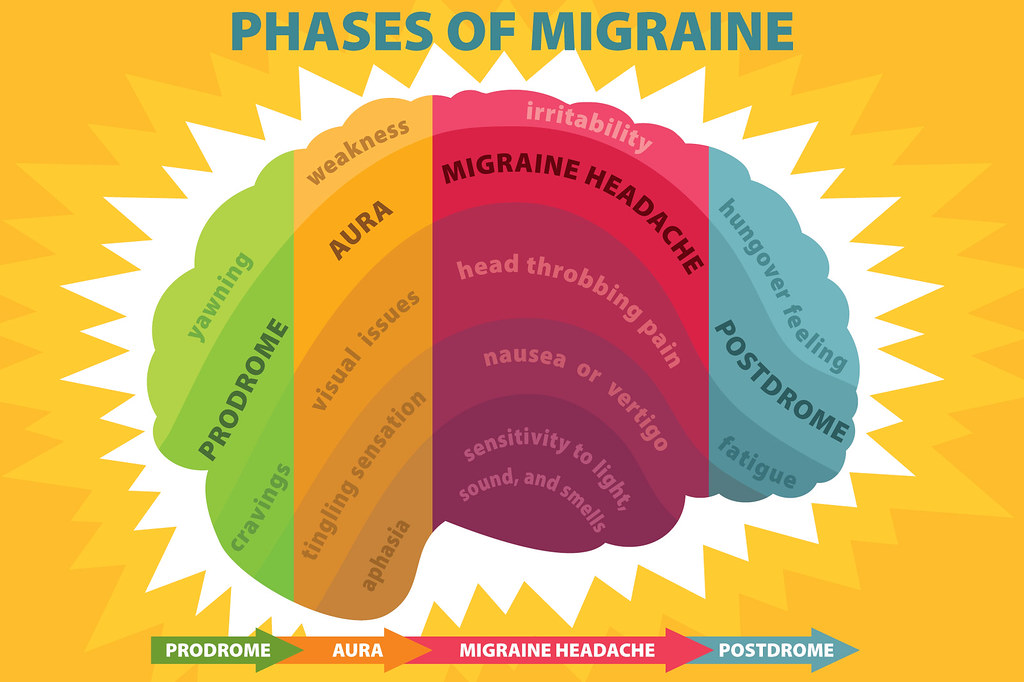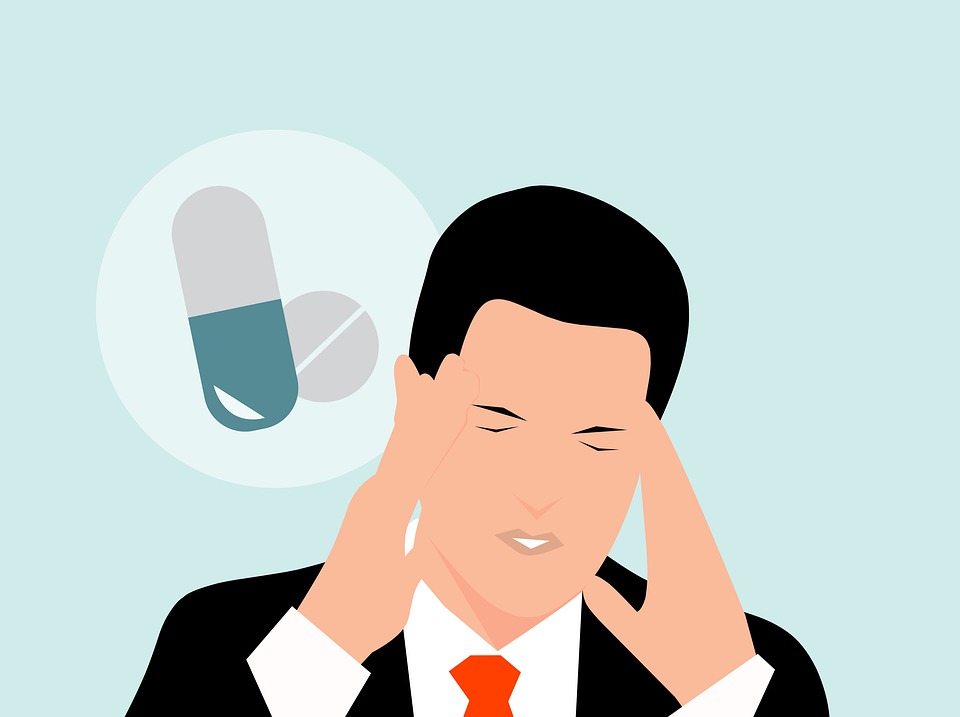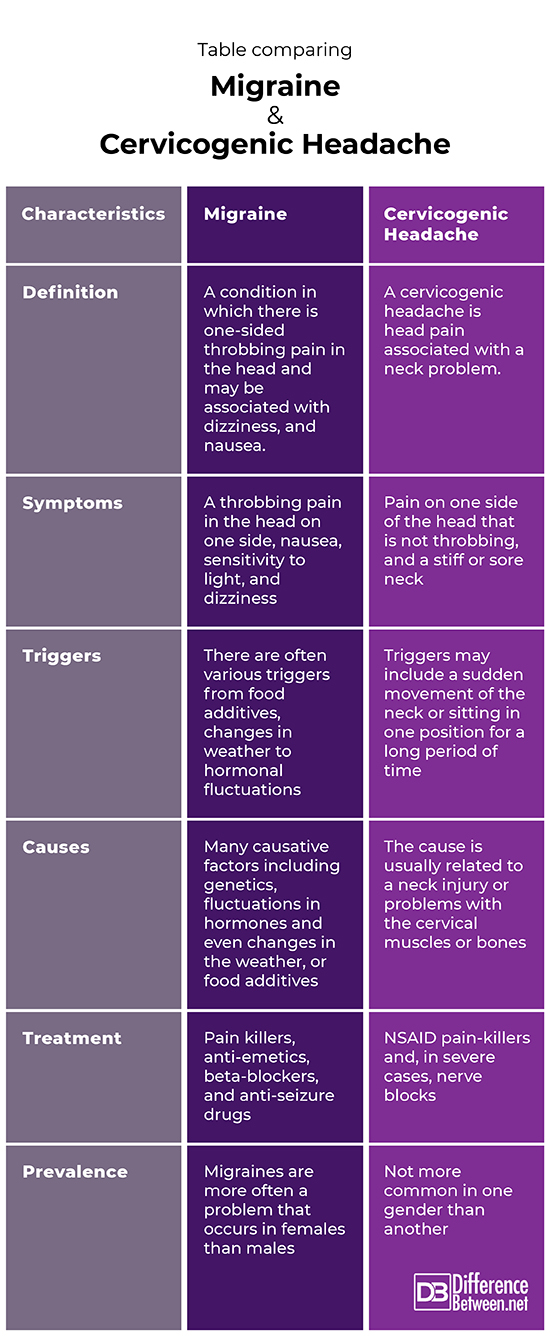Difference Between Migraine and Cervicogenic Headache
A migraine is a medical problem in which there is throbbing head pain and other neurological problems. A cervicogenic headache is a type of head pain caused by neck problems.

What is Migraine?
Definition:
A migraine is a severe throbbing headache and may be associated neurological problems such as dizziness, nausea, and light sensitivity.
Symptoms:
Often, people have an early warning sign of a migraine called an aura. The aura may include seeing flashing lights, blurred lines or nausea. The pain is always on one side of the head and is always of a throbbing nature. Migraines may last from a few hours to a couple of days.
Diagnosis:
Migraines occur more often in females and occur initially in people younger than 50 years old. The symptoms can usually give the diagnosis and imaging tests can be used to exclude other causes such as aneurysms or tumors.
Causes:
Causative factors include certain genetic alterations, hormonal fluctuations, changes in the weather such as air pressure changes, food additives, and even fatigue and stress.
Treatment:
It can be hard to find a treatment that works well and even though analgesics such as ibuprofen or toradol, and anti-emetics, such as phernergan. These medicines can help alleviate the short-term symptoms. However, most people who have frequent migraines usually need to be on preventative medication. Such medication often includes anti-seizure drugs or beta-blockers. These can include medications such as topirimate, carbamezapine or even propranolol.

What is Cervicogenic headache?
Definition:
A cervicogenic headache is actually a result of a problem in the neck, but the person often feels pain in their head.
Symptoms:
Pain occurs when you move your neck or when you sit in one place for a long time. The pain is different from migraines as it does not pulsate or throb but rather becomes continuous. The pain remains in one area and the neck often feels stiff, and sometimes the neck is also painful. E The pain in your head can last anywhere from a couple of hours to several days.
Diagnosis:
The diagnosis is based on a physical examination, noting the symptoms, and particularly noting if there are any neck problems. X-rays, CT scans, and MRI imaging can be helpful in detecting neck problems or in eliminating certain other reasons for head pain.
Causes:
The causes of cervicogenic headaches are usually related to some problem with the neck. This can include pain and strain of muscles or problems with the vertebrae of your neck. This type of headache can also result from injury due to a sport or from whiplash due to a car accident, for instance. Arthritis in the neck region can also lead to this type of headache developing in older individuals.
Treatment:
A cervicogenic headache can be treated using a pain killer such as non-steroidal anti-inflammatory, NSAID, drugs such as ibuprofen. Sometimes a nerve block may be needed to help with pain especially if there is a problem related to nerves in the neck being compressed.
Difference between Migraine and Cervicogenic headache?
Definition
A migraine is a throbbing one-sided head pain in which there is also often nausea and dizziness present. A cervicogenic headache is head pain associated with a neck problem.
Symptoms
Typical symptoms of a migraine include throbbing one-sided head pain, dizziness, photophobia, and nausea. Symptoms of a cervicogenic headache include head pain that does not throb and is continuous, and often also neck pain or neck stiffness.
Triggers
A migraine can be triggered by many factors including food additives, and hormonal or weather changes. A cervicogenic headache can be triggered by a sudden movement or sitting in one position for too long.
Causes
Many factors can cause a migraine, including genetics and various hormonal or weather fluctuations and even some food additives. The cause of cervicogenic headache is a problem with the neck which can be due to an accident or injury.
Treatment
A migraine can be treated temporarily with pain killers and anti-emetics, but long-term preventative medications such as beta-blockers or anti-seizure drugs are usually needed. Cervicogenic headache is best treated with analgesics such as NSAIDs or even a nerve block.
Prevalence
Migraines are more common in females than males while cervicogenic headaches do not appear more common in one gender or another.
Table comparing Migraine and Cervicogenic headache

Summary of Migraine Vs. Cervicogenic headache
- Migraine and cervicogenic headaches both cause head pain, but with migraines the pain is throbbing.
- Both migraines and cervicogenic headaches can cause pain on one side of the head.
- Migraines have many causes and can be treated using various medications including sometimes anti-convulsants or beta-blockers.
- Cervicogenic headaches are usually due to neck problems and are typically treated with NSAIDs or nerve blocks, in cases where pain is severe and due to nerves being compressed.
- Difference Between Rumination and Regurgitation - June 13, 2024
- Difference Between Pyelectasis and Hydronephrosis - June 4, 2024
- Difference Between Cellulitis and Erysipelas - June 1, 2024
Search DifferenceBetween.net :
Leave a Response
References :
[0]Silberstein, Stephen D. “Migraine”. Merckmanuals. Merck & Co., 2018, https://www.merckmanuals.com/professional/neurologic-disorders/headache/migraine
[1]Sjaastad, O., T. A. Fredriksen, and V. Pfaffenrath. "Cervicogenic headache: diagnostic criteria." Headache: The Journal of Head and Face Pain 38.6 (1998): 442-445.
[2]Spadaro, Maria, et al. "A G301R Na+/K+-ATPase mutation causes familial hemiplegic migraine type 2 with cerebellar signs." Neurogenetics 5.3 (2004): 177-185.
[3]Image credit: https://cdn.pixabay.com/photo/2019/07/27/15/41/headache-4367062_960_720.jpg
[4]Image credit: https://live.staticflickr.com/4676/39384099324_92140f7876_b.jpg
